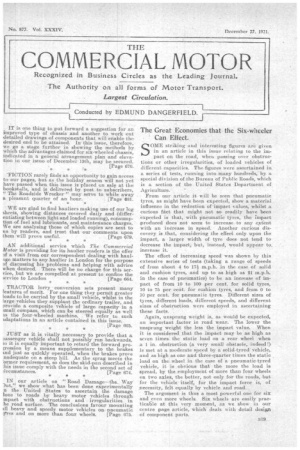The Great Economies that the Six-wheeler Can Effect.
Page 1

Page 2

If you've noticed an error in this article please click here to report it so we can fix it.
pmE striking and interesting figures are given
in an article in this issue relating to the im pact on the road, when passing over obstructions or other irregularities, of loaded vehicles of different capacities. The figures were ascertained in a series of tests, running into manyhundreds, by a special division of the Bureau of Public Roads, which is a section of the United States Department of Agriculture.
From our article it will be seen that pneumatic tyres, as might have been expected, show a material influence in the reduction of 'impact values, whilst a curious fact that might not so readily have been expected is that, with pneumatic tyres, the impact produced does not seem to increase to any extent with an increase in speed. Another curious discovery is that, considering the effect only upon the impact, a larger width of tyre does not tend to decrease the impact, but, instead, would appear to. increase it.
The effect of increasing speed was shown by this extensive series of tests (taking a range. of speeds of from about 4 to 17i m.p.h. in the case of solid and cushion tyres, and up to as high as 21 m.p.h. in the case of pneumatics) to be an increase of impact of from 10 to 100 per cent. for solid tyres, 10 to 75 per cent for cushion tyres, and from 0 to 10 per cent for pneumatic tyres. Different sizes of tyres, different loads, different speeds, and different sizes of obstruction were employed in ascertaining these facts.
Again, unsprung weight is, as would be expected, an important factor in road wear. The lower the unsprung weight the less the impact value. When it is considered that the impact may be as high as seven times the static load on a rear wheel when a I in. obstruction (a very small obstacle, indeed!) is met at a moderate speed by a solid-tyred vehicle, and as high as one and three-quarter times the static load on the wheel in the ease of a. pneumatic-tyred vehicle, it is obvious that the more the load is spread, by the employment of more than four wheels on two axles, the better, not -only for the roads, but for the vehicle itself, for the impact force is, of ;necessity, felt equally by vehicle and road.
The argument is thus a most powerful one for six and even more wheels. Six wheels are easily practicable at this very moment, as we show in our centre page article, -which deals with detail design of component parts.
When one adds the advantages of lessened road wear and lessened wear and tear of the chassis, better adhesion, better braking, better spragging possibilities, reduced running costs, and, in all probability, no increase in capital charges, it must be admitted that an overwhelming case has been made out for the abandonment, for certain types of goods or passenger vehicles, of the four-wheeled principle.
Tractor Lorry Conversion Sets.
T0 the average user of commercial motor vehicles the use of an ordinary type trailer, while it increases the total load capacity of the outfit, appears to be a somewhat cumbrous method of transporting additional loads, particularly as the use of a trailer renders the reversing of the vehicle a matter of considerable difficulty. At the same, time. a user is often desirous of transporting bigger loads without the necessity for purchasing another vehicle. If he carries larger loads than those for which the vehicle is designed, he knows that he will cause his vehicle rapidly to depreciate and, perhaps, have a
• serious breakdown. In such cases the tractor lorry conversion set may prove a highly satisfactory way out of the difficulty. The six-wheeled tractor lorry is now familiar, to practically all users. This type of vehicle is enabled to carry very large loads without unduly increasing the axle weights, and it has the advantage that it can be steered almost, if not quite, as easily as the average lorry. The conversion set consists of a two-wheeled trailer, the front of which is carried on a turntable suitably pivoted above the rear axle of the lorry. In the ease of a short wheelbase machine, such as the Ford ton truck, the trailer carries the complete body, but in the case of an ordinary lorry the platform length of the lorry is utilized for carrying a special body made with a rounded end and undercut to allow room for the turntable. This is really the type which takes the place of an ordinary lorry and trailer, and it can be made much shorter overall than the latter for the same load capacity.' The lorry body is usually foreshortened to a certain extent, and this makes up for the additional load due to the front portion of the trailer, but the bigger portion of the extra load is carried by the wheels of the latter.
In the case of the Ford vehicle, the load on the rear axle of this may actually be less than normal, even with an adapter designed to carry 30 cwt.
The cost of these conversion sets should not he very much greater than that of an ordinary trailer, particularly as they dispense with one pair of wheels.
































